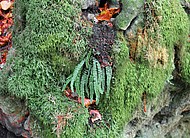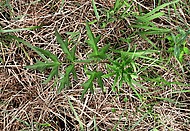Botanical taxonomy, identification and reference literature
In 1753 the Swedish botanist Carl Linnaeus published his work "Species Plantarum" and established the binomial system (genus and species) for naming plants. Since then, every new plant species has had to be described and published in a recognized scientific journal or book. Today, at the International Botanical Congress, rules for plant nomenclature will be established.
Specimens of plants and fungi collected in the field are brought to the Museum of Natural History in an almost constant stream. They are the raw material, the building blocks of botanical knowledge. Pressed between sheets of paper and accompanied by field notes, they are waiting to be identified, catalogued, classified and analyzed.
Experts in systematics document and group organisms in a way that reflects their evolutionary relationships, using a variety of techniques to learn the basic characteristics of a studied plant, from simple measurements of plant parts and shapes to more sophisticated microscopic, biochemical and molecular approaches. Then they can assign the plant to a specific taxonomic group based on its similarity to others, and correspondingly describe and classify new species for science.
The daily tools of the botanists are identification keys, area overviews, biotope and habitat classifications and the like. On the basis of new research results, ecological data and updated lists of species, these tools also have to be "honed" all the time. By means of own research and in the synopsis of different fields, the aim is to create practical literature and to revise existing works.
Literature:
Casper SJ; Bussmann RW; Henning T (2020) Pinguicula rosmarieae Casper, Bussmann and T. Henning (Lentibulariaceae):a new butterwort from the Amotape-Huancabamba Zone (northern Peru). PhytoKeys 140:107-123. doi: 10.3897/phytokeys.140.49529
Romero-Hernández, C., Téllez-Valdés, O., Bussmann, R.W. (2019). Dioscorea chusqueifolia (Dioscoreaceae):a new species from northern Peru Brittonia, doi 10.1007/s12228-019-09587-8
Romero, C., Bussmann, R.W., Puppo, P. (2017). New Species of Calceolaria (Calceolariaceae) from Northern Peru. Novon 25(3):316-321. doi: 10.3417/D-16-00013.
Bussmann, R.W., Paniagua-Zambrana, N.Y., Vega, C. (2013). Axinaea carolinae-telleziae (Melastomataceae) – another new species from Northern Peru. Arnaldoa 20(1): 19-24.
Bussmann, R.W. (2013). Blakea nareliana (Melastomataceae) – a new species from the upper Huallaga in Northern Peru. Revista Peruana de Biologia, 20(2):121-124.
Bussmann, R.W., Paniagua-Zambrana, N.Y., Tellez, C. (2013). Plukenetia carolis-vegae (Euphorbiaceae) – a new useful species from Northern Peru. Economic Botany, 67(4):387-392.
Bussmann, R.W., Paniagua-Zambrana, N.Y. (2012). Axinaea ninakurorum (Melastomataceae) – a new species from the Northern Peruvian Merianeae hotspot. Arnaldoa 19(1):23-27.
Bussmann, R.W., Gruhn, J., Glenn, A. (2010). Axinaea fernando-cabiesii and A. reginae spp. nov. (Melastomataceae) from upper Amazonia of Peru, with notes on the conservation status of A. flava. Nordic Journal of Botany 28: 518-522.
Bussmann, R.W., Téllez, C., Glenn, A. (2009). Plukenetia huayllabambana (Euphorbiaceae) – a new useful species from the Upper Amazon of Peru Nordic Journal of Botany 27: 313-315.
Cotton, C., Bussmann, R.W., Lozano, P. (2004). Three new Ecuadorian Species of Axinaea (Melastomataceae). Nordic Journal of Botany 23: 49-55.
Selected Publications
- Kwak, M; Bussmann, RW. (2023):
- The complete chloroplast genome sequence of Rhododendron caucasicum (Ericaceae). Korean Journal of Plant Taxonomy 53(3), doi: 10.11110/kjpt.2023.53.3.230: 230-236
- Simmel, J; Ahrens, M (2023):
- Bestimmungsschlüssel für vegetative Pflanzen der Brachytheciaceae Mitteleuropas und Nachtrag der Ellenberg’schen N-Zahlen für bislang fehlende Arten. Hoppea 83
- Simmel J., Ernst J. (2021):
- Inventing Nature: Wieviel Botanik steckt in der Kunst?. Staatliche Kunsthalle Karlsruhe, Inventing Nature. Pflanzen in der Kunst , Snoeck: 239-243
- Simmel J., Ahrens M., Poschlod P. (2020):
- Ellenberg N values of bryophytes in Central Europe. Journal of Vegetation Science doi: 10.1111/JVS.12957
- Simmel J., Fischer M. (2018):
- Bestimmungsschlüssel für die Arten der Gattungen Phellinus s. lat. und Inonotus s. lat. (Hymenochaetales) in Mitteleuropa, unter besonderer Berücksichtigung resupinater Wuchsformen. Regensburger Mykologische Schriften 18: 199-214
- Simmel J., Poschlod P. (2017):
- Beiträge zur Bestimmung und Ökologie der mitteleuropäischen Leucobryum-Taxa. Herzogia 30 (2): 397-411
- Simmel J., Rubanschi S., Poschlod P. (2016):
- Zustandsbewertung der Populationen von Kennarten des FFH-Grünlands bei unterschiedlichem Management – Ergebnisse aus den Offenhaltungsversuchen des Landes Baden-Württemberg. Naturschutz und Landschaftspflege Baden-Württemberg 78: 7-44
M.Sc. Jonas Baensch
Phone: +49 721 175-2850
E-Mail: jonas.baensch@smnk.de

Prof. (Ilia State University, Tbilisi, Georgia) Dr. rer. nat. Dipl. Biol. Rainer W. Bussmann
Phone: +49(0)721 175 2848 / 2877 / +49 176 92155014
E-Mail: rainer.bussmann@smnk.de








